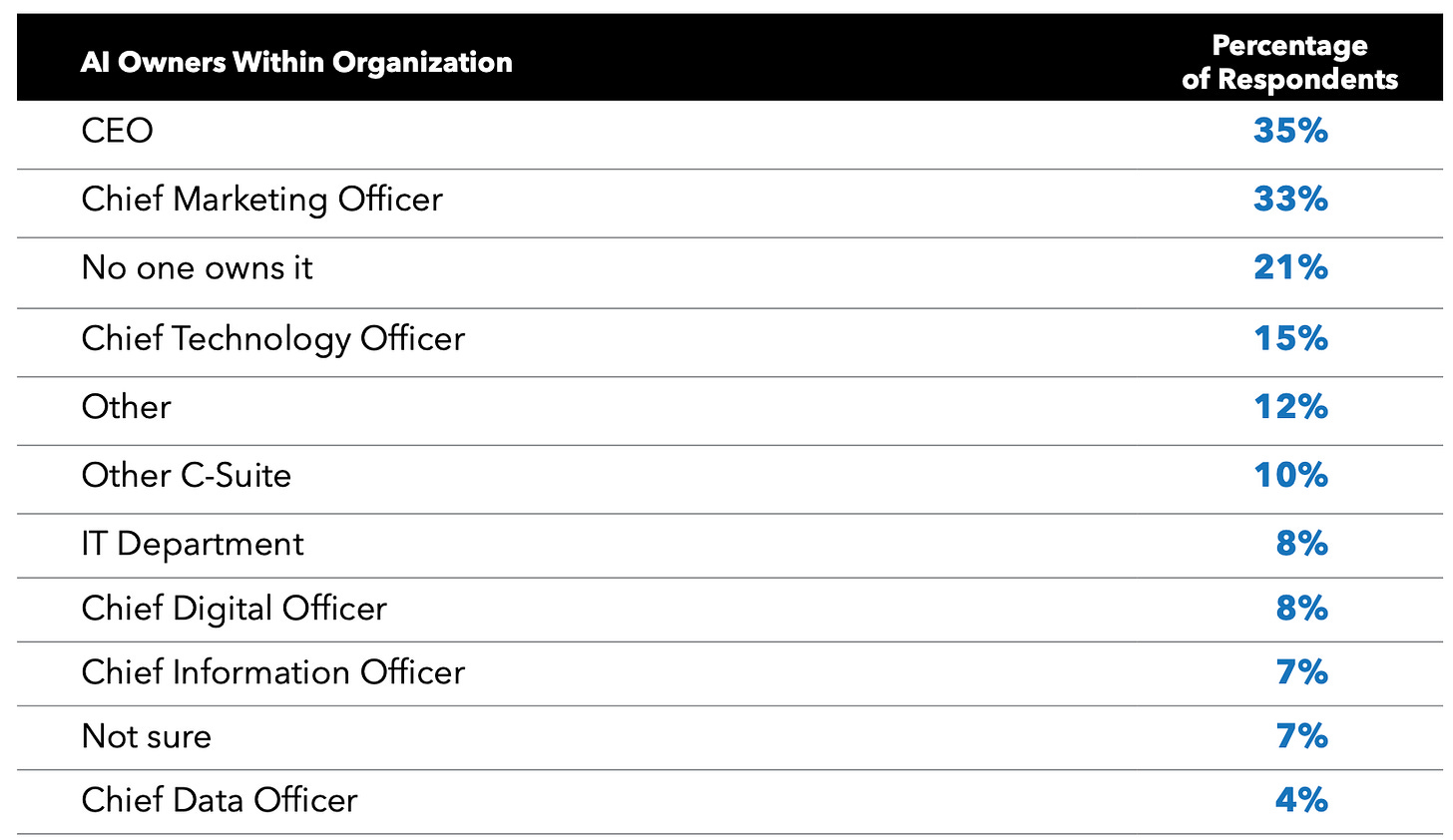According to Goldman Sachs, the adoption of AI over the next 10 years could bring a $7 trillion increase in GDP but also expose over 300 million jobs.
Now is the time organizations need to develop short and long-term strategies to understand and transform the way they do business. If you overthink this, you’ll get lost in analysis or the dust from competitors. But if you move without aligning your values and human resources, you could destroy your trust and culture.
To aid you in your planning, I have put together these steps for organizational AI transformation. The 5-steps we focus on are, Ownership, Policies, Training, Impact, and Workflow.
1. Who Owns “AI” In Your Organization?
The first thing you need to do is determine who owns AI. Who will research generative AI and stay in touch with the developments and use cases for your organization?
This could be an individual or an AI council.
In most companies, AI ownership seems to be either the CEO, CMO, or CTO. See the chart below from the Marketing AI Institute.
2. What Is Your AI Policy?
Now that you’ve established AI ownership, you will want to first create an AI policy to guide and direct your adoption strategy. Some of the main concerns you should look into are (1) regulatory compliance (2) risk mitigation (3) data protection (4) customer trust and loyalty (5) ethical considerations (6) talent acquisition and retention.
Your relationships with employees, customers, and the government are essential for protecting yourself while utilizing AI.
For examples of AI policies, here are a few resources to get you started.
The Responsible AI Manifesto for Marketing and Business from the Marketing AI Institute
Kristina Podnar’s Digital Policy Books and Resources
3. Training, Retooling, and Development
Training has always been important but with generative AI’s power to transform and disrupt every office job, it needs to be a core focus. How much time and money will you dedicate to training and retooling your team? Will you need or want to hire prompt engineers or specialists who already understand generative AI?
Your AI policy should be an asset here.
As you approach and prioritize your strategy, think about the implications to your stakeholders, values, and company vision.
This leads us to the sub-topic of doing an impact exposure assessment.
4. Impact Exposure Assessment
Generative AI has the potential to replace many many things that are done by today’s workers. As you research and think about how you can take advantage, you may see that your staffing needs could change greatly.
The resources below help you weigh many factors in how transforming your organization with AI could impact things. But note, I do think it’s critical to understand that integrating and leveraging AI is not an “if.” It’s a when.
It’s not optional if you want to survive and remain competitive and profitable.
Here are 3 resources for you to review:
7 Critical Questions on from AI Impact Assessments from Bipartisanpolicy.org
AI Risk Management Framework from the National Institue of Standards and Technology
The US Department of Energy has an incredibly comprehensive playbook of AI risks that could provide you with additional matters to consider
5. AI Workflow Matrix
The final asset to help your organization with AI transformation is the AI Workflow Matrix. This resource was previously described in detail in my last post so I won’t go into much depth on it.
The main point I’d like to highlight is the importance to assessing your business independently and before you start to pilot major applications. I have found many individuals and teams experimenting with AI tools like ChatGPT and Midjourney without a clear strategic idea of where their opportunities lie. As such, I created the AI Workflow Matrix to make that identification process easier.
Once of narrow in on your big opportunities, you can then begin piloting software applications.
Final Resources
If you are looking for resources to guide you in AI Transformation, I’d recommend these to start.
Kristina Podnar - Digital Policy Consultant





